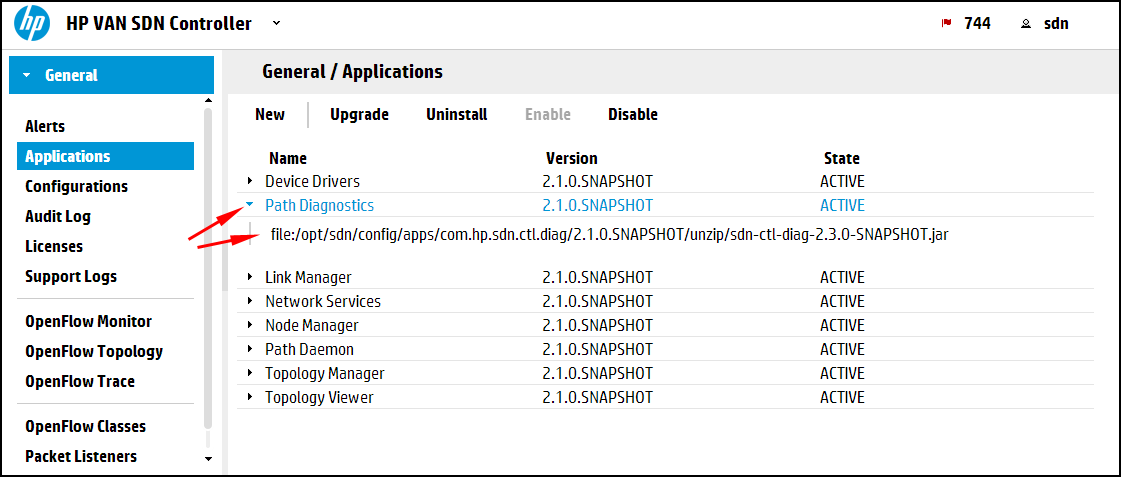The Application Manager supports default and add-on network services, and enables installing, upgrading, enabling (starting), disabling (stopping), and uninstalling SDN applications.
When controllers are operating in a team, actions performed on one controller are propagated to the other controllers in the team. Actions you select in the Applications window for one controller, such as Install, Enable, and Disable, are propagated to the other controllers.
For information about the embedded applications, see “Understanding the controller embedded applications”.
| Screen component | Description |
|---|---|
| Reloads the view. | |
Installs an application on the controller. | |
Installs an upgrade to an application that has already been installed on the controller. | |
Removes an application from the controller. | |
Starts or allows an application to continue operations on the controller. | |
Stops or prevents an application from operating on the controller. | |
| Name | The name of the application |
| Version | The version number of the application |
| State | The most common states are Active, Staged and Disabled. |
When the AppStore becomes available you will be able to purchase and download applications for your controller. Until the AppStore becomes available, the following buttons do not access AppStore features:
Log in to view applications…
Launch AppStore
Any application in the proper format can be added to the controller (see “About the application manager”).
After you complete this procedure:
Use this procedure to install either a new application or a new version of an existing application on the controller using the UI.
This procedure temporarily stops an active application from servicing requests, but retains the application on the system. The application remains present on the system and can be restarted when needed. (The application does not automatically restart when the controller restarts.)
This procedure completely removes an application from the controller. To later restore the removed application, see Adding or upgrading an application.
In the default state, or when an application has been started, it is in the ACTIVE state and is servicing requests. Application states include the following:
Application States
| State | Description |
|---|---|
ACTIVE | The application is running and servicing requests. |
STAGED | A new application has been downloaded to the controller and is ready to be installed. |
UPGRADE_STAGED | A new version of an existing running application has been downloaded to the controller and the new version is ready to be installed (upgrade/downgrade). |
INSTALLING | A transitive state indicating a new application is in the process of being installed. |
UPGRADING | A transitive state indicating the existing application is being stopped and a new version of the application is being installed. |
CANCELING | A transitive state indicating a non-installed version of an application is being deleted from the controller. |
DISABLING | A transitive state indicating the application is in the process of being disabled (stopping). |
DISABLED | The application is disabled (stopped). A disabled application is not automatically started when the controller restarted. |
ENABLING | A transitive state indicating the application is being started. |
UNINSTALLING | A transitive state indication an application is being stopped and completely removed from the controller. |
RESOLVED | The application is stopped and not servicing requests. An application can only be in this state when it is stopped externally to the SDN Controller (e.g. the virgo console). |
Error condition management
| State | Description |
|---|---|
NEW > STAGEDNEW > UPGRADE-STAGED | If an error condition occurs when “staging” the application, then it actually does not exist. (Error conditions in this stage clean up after themselves.) |
STAGED > ACTIVE | If an OSGi deployment exception is encountered, the application is moved to DISABLED if it fails to deploy as it is. If a File I/O or URI exception is encountered, the application remains in the installing state. |
UPGRADE-STAGED > ACTIVE | If an exception is encountered (OSGi deployment, File I/O, or URI), rollback attempt is made, as listed below. (Depending on the original exception, not all options may be possible).
|
ANY STATE – UNINSTALLED | If any exception is encountered, the application remains in UNINSTALLING state |
ANY STATE – DISABLED | If an exception is encountered, remains in DISABLING state. |
DISABLED > ENABLED | If an OSGi deployment exception is encountered, the application is moved to the DISABLED state if it fails to deploy as it is. If any other exception is encountered (file I/O or URI), the application remains in the ENABLING state. |
To access the link to the OSGi artifacts for an application, click on the bullet for the application in the web GUI. For example, clicking on the bullet for the “Path Diagnostics” application displays the link to identity of the associated OSGi artifacts:




